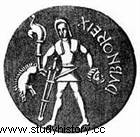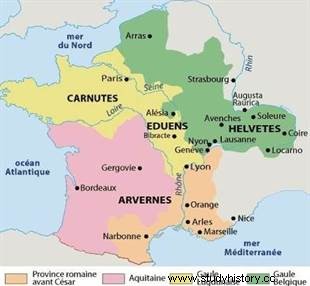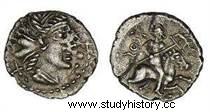 The evocation of "our ancestors the Gauls" today certainly triggers a controversy, and the teaching of their history (and through them, of ours) is often caricatured. However, we know today that the Gauls were plural, both in their structures and in their relations with Rome, but also among themselves, and that this plurality is perhaps also one of the riches of our "roots" (even if this very term is also discussed). The Aedui were one of those peoples, singular in many points, and especially in their relations with Rome; we are therefore going to get to know them, more specifically through their successive capitals, interesting markers of their evolution and their relationship to Rome.
The evocation of "our ancestors the Gauls" today certainly triggers a controversy, and the teaching of their history (and through them, of ours) is often caricatured. However, we know today that the Gauls were plural, both in their structures and in their relations with Rome, but also among themselves, and that this plurality is perhaps also one of the riches of our "roots" (even if this very term is also discussed). The Aedui were one of those peoples, singular in many points, and especially in their relations with Rome; we are therefore going to get to know them, more specifically through their successive capitals, interesting markers of their evolution and their relationship to Rome.
The Aedui, Celtic “brothers” of Rome
We know that the Gauls are part of the Celtic people who originated from Central and Eastern Europe, and who settled in the future Gaul around the 6th century. century BC. We know very little about them until the 2nd century BC, when the “civilization of the oppida developed. (singular oppidum):the Aedui are a good example of this, and then settle in what Caesar in “The Gallic Wars” calls cities, to become above all an economic and commercial power. If the oppida are fortified places, they are first of all great economic and cultural centers, well served by suitable communication routes, and always located near deposits of raw materials. For example, the oppida of Bibracte (135 ha) or Alésia (97 ha) show the importance of these places, far from the image of disorganized barbarians that we usually have about the Gauls.
 The history between the Aedui and Rome begins around 120 BC, when the Romans conquer the Arverne Bituit, and thus put an end to Arverne domination over the peoples of the future Gaul. These are the Aedui who benefit the most, and who very quickly approach Rome through commercial and military agreements. If we do not know all the details of this alliance, we know from Latin authors (like Tacitus) that it is very strong; indeed, the Aedui are called “fratres consanguineique populi romani”, a title which only the Trojans (that is to say the people of Aeneas, founder of Rome) benefited from before! Relations between the Aedui and Rome are therefore very strong, especially at the economic level, and it is in the interest of the Republic to have allies who benefit from such a strategic position. It is therefore not surprising that, when the Aedui called on Rome for help in 58 BC in the face of the Helvetian threat, a certain Julius Caesar came to help them...
The history between the Aedui and Rome begins around 120 BC, when the Romans conquer the Arverne Bituit, and thus put an end to Arverne domination over the peoples of the future Gaul. These are the Aedui who benefit the most, and who very quickly approach Rome through commercial and military agreements. If we do not know all the details of this alliance, we know from Latin authors (like Tacitus) that it is very strong; indeed, the Aedui are called “fratres consanguineique populi romani”, a title which only the Trojans (that is to say the people of Aeneas, founder of Rome) benefited from before! Relations between the Aedui and Rome are therefore very strong, especially at the economic level, and it is in the interest of the Republic to have allies who benefit from such a strategic position. It is therefore not surprising that, when the Aedui called on Rome for help in 58 BC in the face of the Helvetian threat, a certain Julius Caesar came to help them...
Bibracte and the Gallic Wars
Caesar is then governor of Cisalpine Gaul, and takes advantage of this help given to the Aedui to settle:the conquest does not say its name, but it has begun! On the Aedui side, we are divided regarding the attitude to adopt:César meets the three main leaders based in Bibracte, the capital. Liscos is the Aedui supreme magistrate, and opposes Dumnorix whom he accuses of wanting to betray Rome; this one is an important noble, rich and possessing a personal cavalry, he also dreams of an "Aedui nation" more independent of Rome... Finally, Divitiac is the brother of Dumnorix:he is "the most respected of the Aedui" , a member of the College of Druids, and it was he who had personally gone to Rome to seek help from the Senate during the Sequani and Arverni threats (in vain). He does it again by addressing Caesar directly so that this time he pushes back the Germans of Ariovistus; it is a success, but the Aedui become even more dependent on Caesar's legions, to whom they owe support and supplies. Discontent is brewing, and Dumnorix takes advantage of it by refusing to accompany Caesar to Brittany in 54 BC! This time the proconsul is less patient, and the Gallic leader is caught and executed... Legend says that he cries out for his freedom and that of his city before being killed. At the same time, Divitiac "disappears"!
 The revolt is booming throughout Gaul because of the lasting Roman presence:it's time for the uprising with Vercingetorix l'Arverne! But the Aedui find themselves stuck between "Gallic solidarity", quite relative for peoples who have constantly waged war on each other, and its interests which are logically turned towards Rome. They therefore decide not to engage, while making sure not to help the Romans... Caesar does not hear it that way and puts pressure on the Aedui by playing on their divisions:he supports Convictolitavis who installs Litaviccos at the head of the Aedui army in charge of supporting the legions. But on the road to Gergovia, Litaviccos turns against the Romans, loots the supply convoy and flees! Caesar manages to catch up with his troops, and the Gallic chief joins Gergovie alone... But pushed back from Gergovie, Caesar still has to face an Aedui rebellion when he intended to entrench himself in Bibracte! It is led by Eporedorix. At this moment, the Aedui have finally chosen their camp:that of the Gauls. An assembly is convened at Bibracte, and Vercingetorix is elected chief of the Gauls, near the stone of the Wivre.
The revolt is booming throughout Gaul because of the lasting Roman presence:it's time for the uprising with Vercingetorix l'Arverne! But the Aedui find themselves stuck between "Gallic solidarity", quite relative for peoples who have constantly waged war on each other, and its interests which are logically turned towards Rome. They therefore decide not to engage, while making sure not to help the Romans... Caesar does not hear it that way and puts pressure on the Aedui by playing on their divisions:he supports Convictolitavis who installs Litaviccos at the head of the Aedui army in charge of supporting the legions. But on the road to Gergovia, Litaviccos turns against the Romans, loots the supply convoy and flees! Caesar manages to catch up with his troops, and the Gallic chief joins Gergovie alone... But pushed back from Gergovie, Caesar still has to face an Aedui rebellion when he intended to entrench himself in Bibracte! It is led by Eporedorix. At this moment, the Aedui have finally chosen their camp:that of the Gauls. An assembly is convened at Bibracte, and Vercingetorix is elected chief of the Gauls, near the stone of the Wivre.
Little is known about Aedui participation following the Gallic Wars. César does not attack Bibracte, yet the center of the rebellion, and finally defeats Vercingétorix at Alesia. But the future dictator now knows the versatility of the Aedui , and decides to settle in Bibracte itself, with his troops; this is where he wrote his "Commentaries" during the winter of 52 BC...
From Bibracte to Autun:the Romanization of the Aedui
As we have seen, Bibracte was an oppidum, the “capital” of the Aedui and a major economic and cultural centre. We note the importance of its fortifications by the reconstruction of the "murus gallicus" of the Rebout gate, and the excavations have shown that the city was organized by districts, over an area of 135 ha. Metalworking also seemed to be a specialty of Bibracte, as evidenced by the presence of many blacksmith and bronze workshops, but also mines in the vicinity of the oppidum. The enigma of Bibracte , it is the famous basin:it is made of materials of Mediterranean origin, and we do not know its function. It was built on the geometric principle of Pythagoras, and we do not know if it had a religious use, if it designated the center of the city, etc.
Be that as it may, and despite the importance of Bibracte for the Aedui, it begins to lose its influence at the end of the Republic, and seems to be deserted little by little. little. This is not due to Roman repression, as Caesar was quick to forgive and needed Aedui support...Perhaps it was the period of peace following the civil wars that prompted Rome to move the Aedui capital from a strategic point but still relatively difficult to access, towards an easier place in the plain:this is the creation of Augustodunum (Autun), which is around 16-13 BC.
Unlike Bibracte, Autun is a real "Roman city", in its construction and its institutions. It also quickly became a very important economic and cultural center, the Aedui having regained their privileged status near Rome. Thus, the city serves as a showcase and starting point for the Romanization of the immense region of which it is the capital. However, the history of Autun thereafter is not always easy:Tiberius (14-37 AD) removes some of its advantages and provokes a revolt quickly crushed; Claudius (41-54) on the other hand, proposed to the Roman Senate to welcome Gauls into its midst, and the Aedui were the first among them... During the troubles following the death of Nero (in 68), the Aedui took the party of Galba, then that of Vitellius. And there, for almost two centuries, Autun and the Aedui disappeared from the sources!
They are logically found during the events leading to the creation of the Gallic Empire :Rome is in the throes of a crisis, beset by barbarians (Autun is sacked by the Alemanni in 259), and a certain Postumus takes advantage of the weakening of Emperor Gallienus to proclaim himself emperor and reign over Gaul! He was finally killed by his troops when he refused to plunder Mainz in 268, and Victorinus succeeded him. The Aedui, still attached to Rome, take advantage of the chaos in Gaul to ask for help from the new emperor, Claudius II; but he refuses or cannot come (he fights the Goths), and Autun finds herself alone in the face of the wrath of Victorinus! He besieged it for seven months in 269, then pillaged and almost razed it.
The end of the Gallic Empire in 271 finally marks the rapprochement between the Aedui and Rome:in the panegyric written by Eumenes in 298, we see that Rome helped Autun to rebuild, especially with Constance Chlore , considered “the friend of the Gauls”. Constantine, his son, went there in 311 and also agreed to help the capital of the Aedui. During the 4th century, Autun seems to regain some of its former glory, but does not really manage to move forward. In addition, Constantine lost interest in Gaul and preferred to turn to the East (foundation of Constantinople in 330). The end of Antiquity is obscure for the city and the Aedui; we just know that Autun was once again on the road to barbarian invasions from the end of the 4th century...
It will only regain a certain importance in the Middle Ages, becoming a place of pilgrimage under Cluniac influence, after having still suffered mistreatment by the Arabs ( in 725) and the Normans (in 888). But that's another story...
Non-exhaustive bibliography
- A. Ferdière, The Gauls (provinces of Gaul and Germanies, Alpine provinces):2nd c. BC-5th c. ap. J.C. , Paris, 2005.
- C. Goudineau, Caesar and Gaul , Paris, 1990.
- Autun, Augustodonum. Capital of the Aedui , Autun, 1985.
- A. Rebourg, Ancient Autun , Paris, 2002.
- Bibracte, Gallic town , Archaeological Guides of France, 1987.
